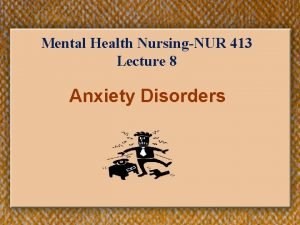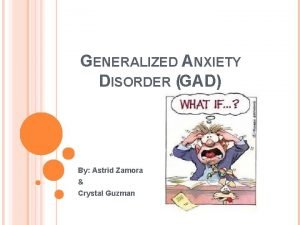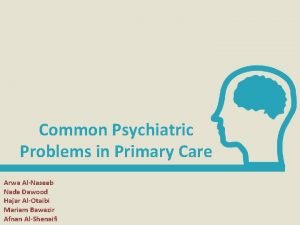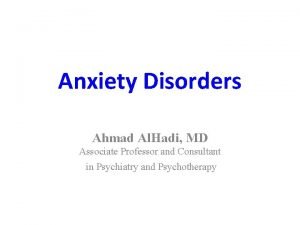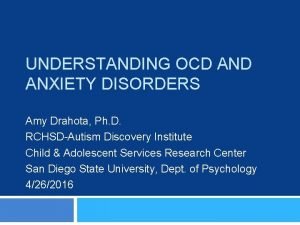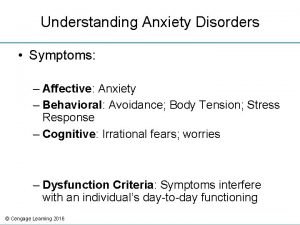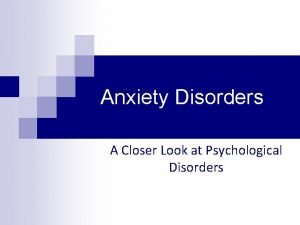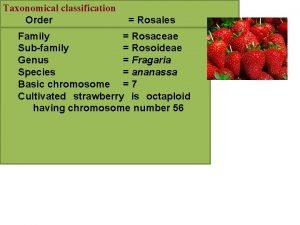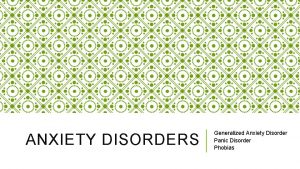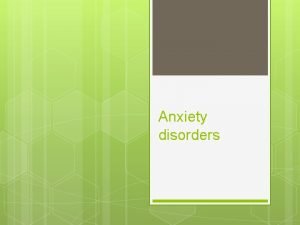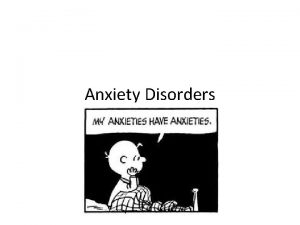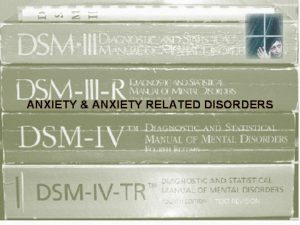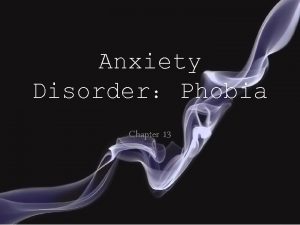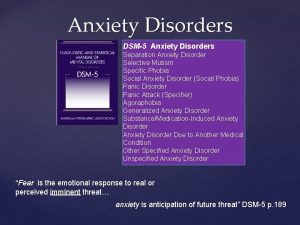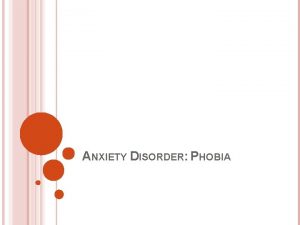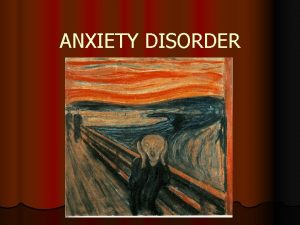Generalized Anxiety Disorder Juan Rosales Definition Its a











- Slides: 11

Generalized Anxiety Disorder Juan Rosales

Definition • It’s a condition when a person worries a lot and unrealistically. Being nervous, restless and dizzy are signs of this disorder.

Associated Features • Excessive, unrealistic & uncontrollable worry about many things: Ex. The economy, job, bills • Physical Symptoms- Muscle tension, sleeping problems, short temper. • Other Symptoms- sweating, shaking, fast heart beat, feeling out of breath, often using bathroom, feeling like fainting, uneasy in a group or in a waiting room.

DSM-IV-TR • A. Excessive anxiety and worry (apprehensive expectation), occurring more days than not for at least 6 months, about a number of events or activities (such as work or school performance). • B. The person finds it difficult to control the worry. • C. The anxiety and worry are associated with three (or more) of the following six symptoms (with at least some symptoms present for more days than not for the past 6 months). Note: Only one item is required in children. • (1) restlessness or feeling keyed up or on edge (2) being easily fatigued (3) difficulty concentrating or mind going blank (4) irritability (5) muscle tension (6) sleep disturbance (difficulty falling or staying asleep, or restless unsatisfying sleep)

Continued • D. The focus of the anxiety and worry is not confined to features of an Axis I disorder, e. g. , the anxiety or worry is not about having a Panic Attack (as in Panic Disorder), being embarrassed in public (as in Social Phobia), being contaminated (as in Obsessive-Compulsive Disorder), being away from home or close relatives (as in Separation Anxiety Disorder), gaining weight (as in Anorexia Nervosa), having multiple physical complaints (as in Somatization Disorder), or having a serious illness (as in Hypochondriasis), and the anxiety and worry do not occur exclusively during Posttraumatic Stress Disorder. • E. The anxiety, worry, or physical symptoms cause clinically significant distress or impairment in social, occupational, or other important areas of functioning. • F. The disturbance is not due to the direct physiological effects of a substance (e. g. , a drug of abuse, a medication) or a general medical condition (e. g. , hyperthyroidism) and does not occur exclusively during a Mood Disorder, a Psychotic Disorder, or a Pervasive Developmental Disorder.

Etiology & Prevalence • The cause is unknown. • It is estimated that about 5% of the people have had this disorder during their lives. • It is twice as much present on women than men.

Treatment • Medicine-Antidepressants • Behavior Therapy, Relaxation therapy, Cognitive therapy & Stress management techniques.

Can last years maybe entire lifetimes. It depends on the person because its difficult to treat. Most patients get better with behavioral therapy and medicine. Prognosis

In your opinion do you think this should be a disorder although people always worry? Discussion Question

References • Halgin, R. P. & Whitbourne, S. K. (2005). Abnormal psychology: clinical perspectives on psychological disorders. New York, NY: Mc. Graw Hill. • Myers, D. G. (2011). Myers’ psychology for ap. New York, NY: Worth Publishers.

CONTINUED • Naakesh A. Dewan, M. D. (2011). Generalized Anxiety Disorder. CRS - Adult Health Advisor, 1. http: //web. ebscohost. com/src/detail? vid=13&hid=108 &sid=7 fe 98388 -b 2 d 7 -4 a 2 b-8 be 01 c 0 a 3 ba 7 fb 2 d%40 sessionmgr 15&bdata=Jn. Npd. GU 9 c 3 Jj. L Wxpdm. U%3 d#db=hxh&AN=70985871 • Zieve, D. (2011, April 11). Medline plus. Retrieved from http: //www. nlm. nih. gov/medlineplus/ency/ar ticle/000917. htm
 Examples of generalized anxiety disorder
Examples of generalized anxiety disorder Examples of generalized anxiety disorder
Examples of generalized anxiety disorder Generalized anxiety disorder dsm 5
Generalized anxiety disorder dsm 5 Agoraphobia vs social phobia
Agoraphobia vs social phobia Short term goal for anxiety
Short term goal for anxiety Explanation of anxiety disorder
Explanation of anxiety disorder Explanation of anxiety disorder
Explanation of anxiety disorder Explanation of anxiety disorder
Explanation of anxiety disorder Factitious disorder vs somatic symptom disorder
Factitious disorder vs somatic symptom disorder Rosoideae
Rosoideae Consejo escolar coronel rosales
Consejo escolar coronel rosales Rosaceae order
Rosaceae order
